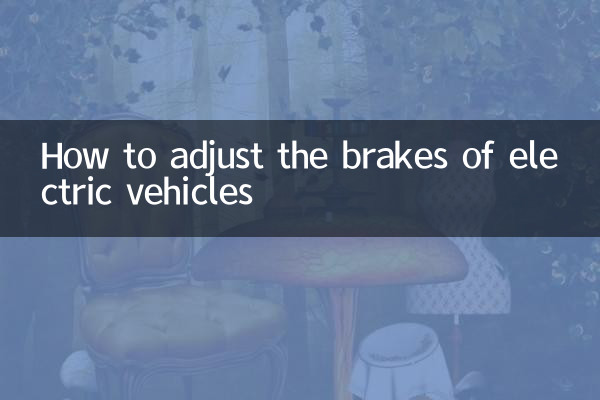How to adjust the brakes of electric vehicles
With the popularity of electric vehicles, the adjustment of the braking system has become the focus of many car owners. Among the hotly discussed topics on the Internet recently, electric vehicle brake adjustment methods, common problems and solutions occupy an important position. This article will combine the hot discussions in the past 10 days to provide you with a detailed analysis of the adjustment steps, precautions and common problems of electric vehicle brakes.
1. The necessity of brake adjustment for electric vehicles

Brakes are the core component for safe driving of electric vehicles. After long-term use, problems such as brake insensitivity, abnormal noise or wear may occur. Regular brake adjustments not only improve driving safety, but also extend the service life of the brake system.
2. Electric vehicle brake adjustment steps
The following are detailed steps for electric vehicle brake adjustment, which are applicable to most common models:
| steps | Operating Instructions | Things to note |
|---|---|---|
| 1. Check the brake system | Check the brake pads for wear and whether the brake lines are loose or rusty | If the brake pads are worn more than 2/3, they need to be replaced. |
| 2. Adjust the tightness of the brake line | Adjust the tightness through the brake line adjustment nut to ensure the brake handle has a moderate stroke | If the stroke is too long, the brakes will become insensitive, and if the stroke is too short, it may lock. |
| 3. Calibrate brake pad position | Loosen the brake pad fixing screw and adjust the contact surface between the brake pad and the wheel hub to ensure a complete fit. | Uneven contact surfaces can lead to abnormal brake noise or reduced efficiency. |
| 4. Test the braking effect | Drive at low speed and test the brakes to see if they are sensitive and make any abnormal noise. | If problems are found, readjustment is required |
3. Recent popular brake problems and solutions
According to online discussions in the past 10 days, the following questions are the most common:
| question | Possible reasons | solution |
|---|---|---|
| Abnormal brake noise | Brake pads are worn, foreign matter has entered, or the contact surface is uneven | Clean the brake system or replace the brake pads |
| The brakes are not sensitive | Loose brake lines, worn brake pads or insufficient brake fluid (hydraulic brakes) | Adjust brake lines or replenish brake fluid |
| Brakes locked | The brake line is too tight or the brake pads are improperly installed | Readjust the tightness of the brake line |
4. Differences in brake adjustment of different types of electric vehicles
The braking system of electric vehicles is mainly divided into drum brake, disc brake and hydraulic brake. The adjustment methods are slightly different:
| Brake type | Adjust focus | Tool requirements |
|---|---|---|
| Drum brake | Adjust brake line tightness and brake shoe position | Wrench, screwdriver |
| Mechanical disc brake | Adjust the distance between brake pad and disc | Allen wrench |
| Hydraulic disc brake | Professional tools are required to bleed air and replenish brake fluid | It is recommended to leave it to a professional maintenance center. |
5. Precautions for brake adjustment of electric vehicles
1.Safety first: Make sure the vehicle is powered off before adjustment to avoid accidental start.
2.Regular inspection: It is recommended to check the brake system every 3 months or after driving 2000 kilometers.
3.Professional assistance: If you are not familiar with adjustment, it is recommended to go to a professional maintenance center.
4.Accessories quality: When replacing brake pads, choose original or quality-reliable accessories.
5.test environment: After adjustment, test at low speed in a safe area and confirm everything is correct before going on the road.
6. Recent hot topics related to brakes
1.New technology for electric vehicle braking: Recently, many manufacturers have launched intelligent braking systems that can automatically adjust braking strength according to road conditions.
2.Braking energy-saving technology: The energy recovery braking system has become a standard feature of high-end electric vehicles, which can extend the cruising range.
3.brake safety regulations: Many places have begun to strengthen supervision of the braking performance of electric vehicles, and unqualified products will be recalled.
Through the above content, I believe you have a comprehensive understanding of the adjustment of electric vehicle brakes. Regular maintenance of the brake system can ensure driving safety and enjoy the convenience of green travel.

check the details

check the details